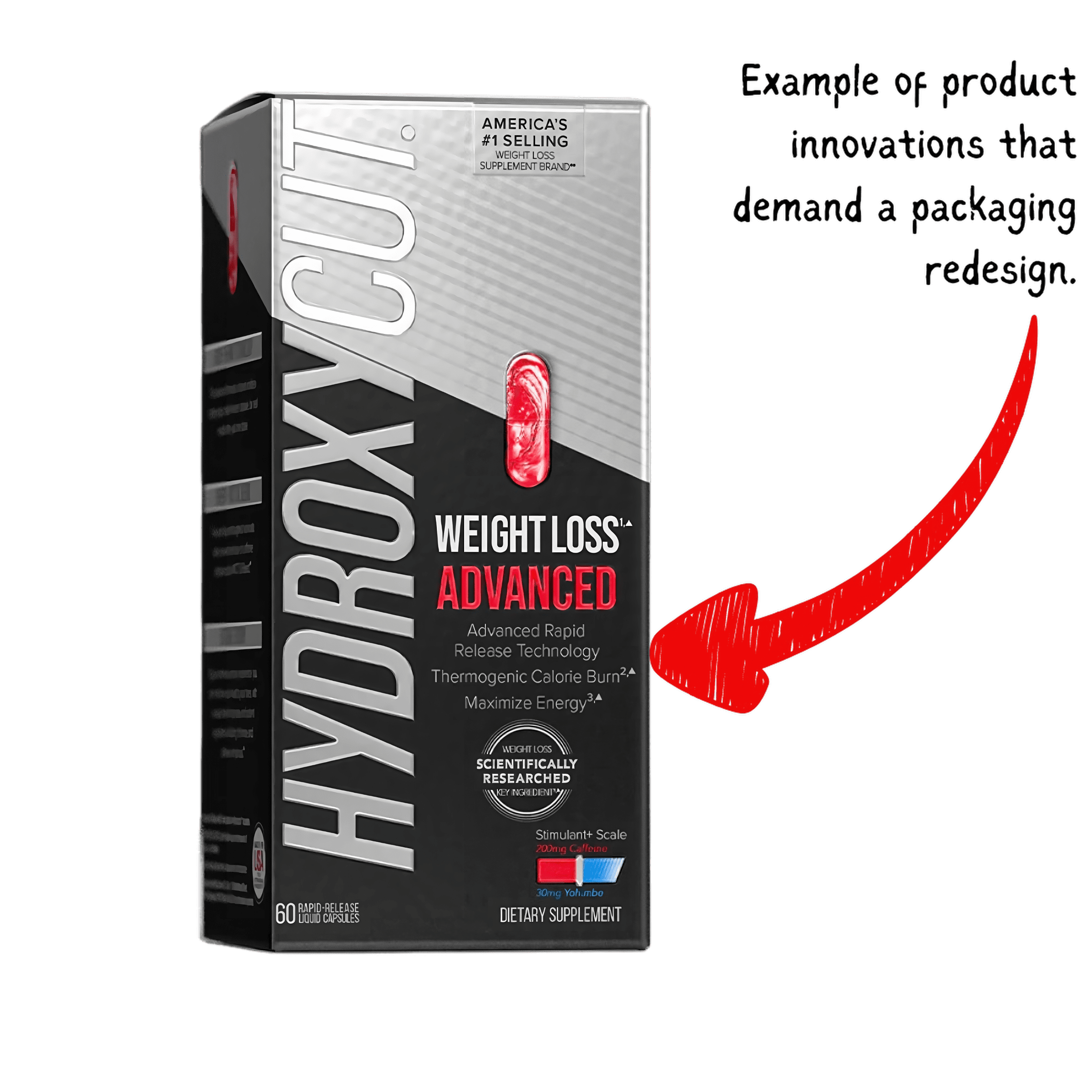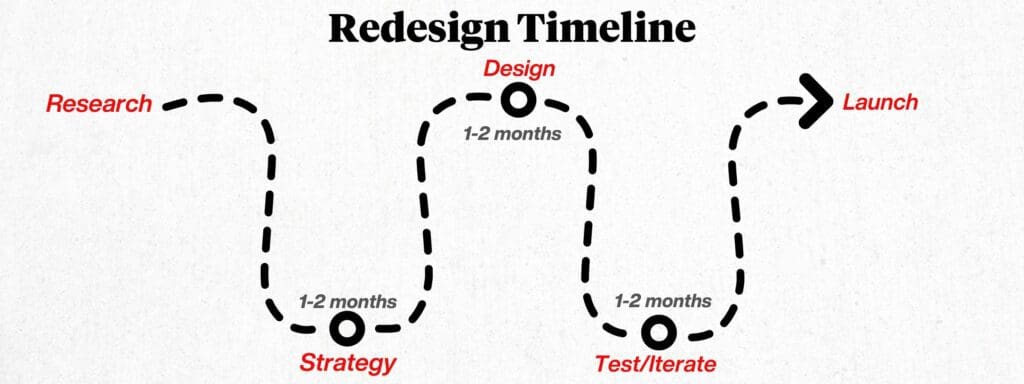In a brand’s lifecycle, one of the most crucial moments that define long-term success is when they undertake a packaging redesign. Though seemingly minor in the grand scheme of business, this event can make or break a brand’s continued success in retail.
In the CPG industry, packaging is the most visible representation of the company’s branding. Not only is it viewed by more people than any other form of marketing, but it’s nearest to the point of purchase, making it even more important.
Not being diligent in the packaging redesign process is a sure way to send revenues on a fast descent. So, in this article, we walk through everything a brand must know about package redesigning, including reasons to redesign, how to execute, and considerations when putting your new design into the marketplace.
Why Redesign Packaging?
Check any CPG media publication, and it will be apparent how brands constantly undergo packaging redesigns, but not always for the right reasons. The most common reasons a company goes through a redesign are:
- Slow sales.
- Product delisting.
- A desire for a more significant market share.
- The time since the last packaging refresh.
While these “may” be good reasons for a new design, they do not accurately describe the problem brands hope a new packaging design will solve. Before beginning a package redesign process, you must understand why the change must occur. Here’s a look at several root causes where a redesign may be necessary.
Change In Product Positioning
As a packaging design agency, our client experience tells us that repositioning is the most common “qualified” reason for changing the product packaging. Sometimes, it’s not so much about the look but the words, their placement, and graphic representations to support the new position.
Read More: A How-To Guide For Brand Repositioning
Change In The Competitive Landscape
CPG categories constantly change, with brands jumping onto packaging design trends and new competitors entering the space. For many brands, the result of these changes is a loss in competitive advantage, with the target customer demanding an update to their product packaging.
Change In Consumer Preferences
Over time, your packaging may become outdated and disconnected from the consumer, whether due to the natural aging of the target audience or changes in social trends that influence preferences. A packaging refresh where you find alignment with current design trends may be necessary to hold onto the target audience but tread carefully not to become white noise with the other brands making similar moves.
Product Innovation
Brands in categories where product innovation is a continual process must consider what product packaging changes must occur to showcase their latest innovations best. We see examples of these changes in industries such as vitamin supplements, automotive, and pet products.
Hydroxycut is a prime example of a product that leverages product innovation to keep it relevant in the marketplace. Each product evolution cuts through the noise with a packaging redesign to showcase the new ingredients and manufacturing advancements.

Sustainability Initiatives
Sustainability is a moving target, and brands are continuously evolving to keep up with the latest advancements in ingredient sourcing and sustainable packaging. Even subtle changes to the overall sustainable strategy, such as product packaging materials, may warrant a packaging redesign.
Shifting From DTC To Retail
Brands that succeed in DTC may not succeed in retail with the same packaging design. In fact, it’s almost guaranteed that the brand will need a product packaging redesign before going to national retailers. Whether it’s a preemptive effort or because of underperforming when placed on shelves, we see almost every DTC brand go back to the drawing board to succeed in retail.
Considerations Before Going Through A Packaging Redesign
Brands must ask several questions before beginning the redesign process to determine whether or not now is the time to engage and what resources are necessary. Here are the two primary considerations.
The Cost Of Redesigning A Package
Undertaking a packaging redesign may be necessary, but brands must carefully consider the cost. Competing against household names in national changes requires an investment and strategy, expert designs, and rigorous testing. The expenses associated with high-level package redesigning will vary depending on the scope of the changes, the complexity of the design, and the expertise of the packaging design agency involved.
Brands must invest in this process diligently, as not doing so can lead to a revenue drop. The cost includes:
- Design agency fees.
- Consumer testing.
- New packaging materials.
- Marketing efforts to promote the redesigned packaging effectively.
However, the benefits of a successful packaging redesign can outweigh the initial investment by attracting more customers, enhancing brand perception, and ultimately driving higher sales.
The Time-Line Of A Redesign
Considering the time it takes for a packaging redesign is a reality check for many brands. The process typically spans 4-6 months, encompassing strategy development, design conceptualization, rigorous testing, and multiple iterations. This timeline allows for thorough market research, thoughtful design ideation, meticulous testing for functionality and appeal, and ample room for refining the packaging to achieve optimal results. If you do not have the time to do it right, you may need to rethink the redesign initiative.

Packaging Materials
When undergoing a packaging redesign, the choice of packaging materials impacts the supply chain, cost of production, and product experience. Packaging materials impact the product’s aesthetics and influence its sustainability, durability, and protection capabilities. In this socially conscious climate, brands must carefully consider the environmental impact of their packaging choices and align them with their sustainability initiatives, as consumers are increasingly conscious of eco-friendly packaging options.
Additionally, selecting high-quality materials can enhance the product’s perceived value, potentially increasing customer satisfaction and brand loyalty. Collaborating with suppliers who provide innovative and sustainable packaging solutions can ensure that the redesigned packaging aligns with the brand’s values and meets the evolving preferences of the target audience.
Executing An Effective Packaging Redesign
Much of our work comes from brands that previously hired design firms to create eye-catching packaging. Regrettably, these firms often lack the essential elements required for an effective packaging design that can confidently impact the competitive market. So, a founder or brand manager comes to us for a packaging redesign to prevent delisting from store shelves.
Here’s a look at the SmashBrand methodology for redesigning product packaging.
Brand Research
Every good package redesign strategy begins with brand, category, and consumer research. This process seeks to understand what branding assets to leverage to keep loyal customers, where there is a competitive gap for distinct positioning, and how to present the brand to attract the target audience.
Strategic Design
For most companies, strategy concludes once the research phase is complete, where they proceed with redesigning the packaging. Documentation of their findings is handed off to the creative director, who then instructs the graphic designer to create a few design concepts to see what the brand likes and dislikes.
An approach such as this is not enough to compete in competitive categories. It puts too much weight on the marketing department to attract consumers to a product when the product should be the main lever doing this job.
A strategic process involves continuous refinement of designs in an iterative manner. It’s a process that requires consumer testing throughout each design iteration.
Consumer Testing
Consumers should ultimately influence your product packaging redesign. Gathering their feedback from the initial messaging and graphic representations to the final design concept ensures that the packaging has the maximum impact. Non-existent or insufficient testing is a primary reason why many brands fail when entering retail channels.
Taking Your Redesign To Market
The best packaging redesign will succeed only when an effective go-to-market strategy supports the new look. Brands must implement a diligent process to ensure the new redesign replaces all branding that includes or supports the existing packaging. The job of guaranteeing brand congruency will be the responsibility of a team, but the brand manager is typically the one in charge of leading this initiative.
Here’s a look at what a brand should consider when taking their packaging redesign to market.
Marketing & Promotion
There are many marketing components for brands selling nationally or internationally, and it’s easy to make mistakes when changes such as a redesign occur. Clear communication with all marketers on your team is paramount to the success of this package design relaunch.
But it isn’t just the packaging itself that we are redesigning. A brand must thoroughly analyze all design elements to ensure there are no design themes and product messaging inconsistencies.
Vendor Communications
While the vendor might believe your exhaustive communication on this packaging transition to be overkill, you must do everything possible to update channel partners, ensuring they understand that the old packaging is no longer an accurate brand representation. Not doing so leads to products being placed incorrectly on shelves or poor in-store assistance for consumers who seek your brand or product category. Both result in lower brand recognition and visibility on the shelf.
Reporting The Success of The Redesign
It’s shocking how many brands cannot quantify the impact of their new design. Understanding the changes in brand perception, purchase frequency, lifetime value, and product revenues not only helps you understand the benefits of this redesign but also sets the standard for future designs.
Nowadays, there is no excuse for not having actionable data through any branding campaign.
Packaging Redesign Agency For CPG Brands
If you are looking to see a performance lift in retail, we can help. SmashBrand is a brand development agency that researches, designs, and tests all products to ensure peak shelf performance. Book a time to discuss your project with our team.
Subscribe to
Nice Package.
A monthly newsletter that unpacks a critical topic in the FMCG & CPG industry.
Free Resource.

CPG product repositioning guide.
Explore the five undeniable signs your CPG product needs repositioning along with strategies for leveraging consumer insights for a guaranteed market lift.
Learn More About CPG product repositioning guide.